

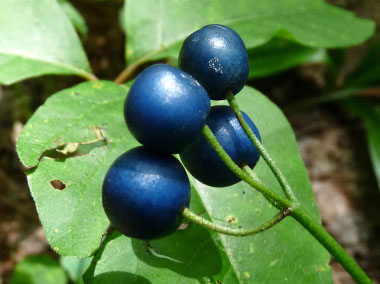
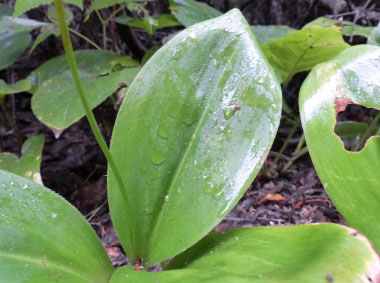

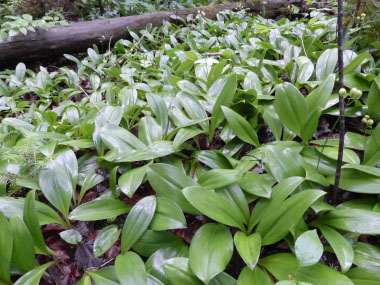
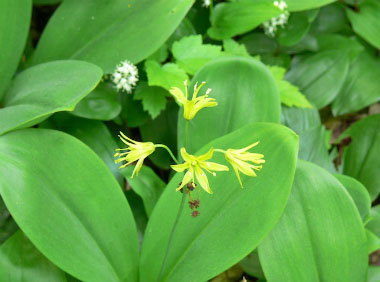
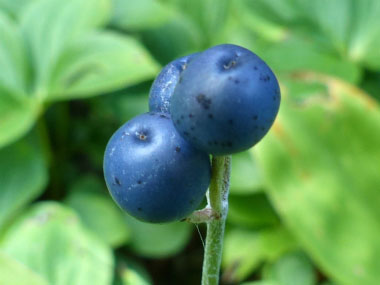
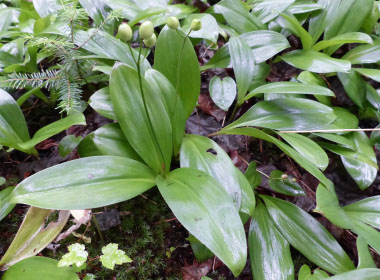
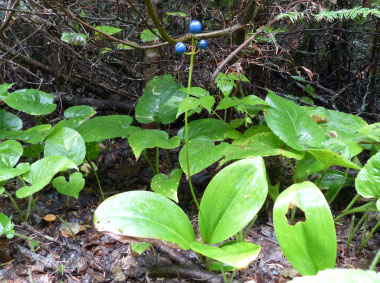
To support our efforts please browse our store (books with health benefits, etc.).
Blue bead lily is a perennial plant that is a member of the Liliaceae family. This boreal plant also known by many names such as: Blue Bead Lily, Clintonia, Clinton’s Lily, Corn Lily, Snakeberry, Dogberry, and Cow Tongue. Bluebead was named after DeWitt Clinton (1769-1828), naturalist and once New York governor. This plant reproduces by seed and vegetatively by rhizomes division hence the reason there are many of these plants in some areas. Bluebead is native to boreal forests of eastern North America. One colony of bluebeads often covers several hundred square meters; yet few plants can actually establish new colonies
Distinguishing Features
The broad, fleshly leaves at the base give way to a single stem topped with pale yellow flowers in late spring. In the summer, those flowers turn into beautiful, yet toxic, bright blue berries. These lilies often grow in dense mats in forests.
Flowers
Flowers form in a loose umbel-like terminal cluster of 2 to 8 flowers. They are nodding and the petals and sepals are alike. It is yellow to greenish-yellow, oblong to lanceolate, measuring up to 1.6 cm (.6”) long. Each flower has six stamens which are slightly longer than the petals; Flowers anywhere from May to July depending on location. Each flower bears a poisonous blue berry.
 Fields
of Nutrition has medicinal benefits and vitamin/mineral content of Bluebead.
Fields
of Nutrition has medicinal benefits and vitamin/mineral content of Bluebead.
Leaves
Each plant produces (typically) three leaves that are elliptic to narrowly obovate. (Although some plants can have 2-5 leaves.) They grow up to 30 cm (12”) long and 10 cm (3.9”) wide. The leaf is light green, glossy and somewhat stiff. Margins are smooth.
Height
The stem grows to a height of anywhere between 15 and 40cm (5.9 – 15.7”).
Habitat
Blue bead lilies like the rich soils of coniferous and deciduous forests. This plant can also be found in bogs, and sometimes in sub-alpine meadows. They grow in cooler temperature maple forests as well. In Canada this plant grows from Manitoba to the east coast. In the U.S. it grows mostly in the northeastern states as well as far south as Georgia and west to Minnesota.
Edible Parts
Young leaves are edible raw or cooked. This is best harvested in spring before the leaves unfurl. Older leaves can be used as a potherb. NEVER consume any other part of this plant!
Other Name
Yellow Bluebead Lily.
Special thank you goes out to Macphail Woods for allowing us to use their image of the bluebead yellow flowers.
Winter Survival Food Handbook

PDF Plant Magazines
Types of Wild Food
Geographic Zones Seasons
Disclaimer
EdibleWildFood.com is informational in nature. While we strive to be 100% accurate, it is solely up to the reader to ensure proper plant identification. Some wild plants are poisonous or can have serious adverse health effects.
We are not health professionals, medical doctors, nor are we nutritionists. It is up to the reader to verify nutritional information and health benefits with qualified professionals for all edible plants listed in this web site. Please click here for more information.
Why Edible Wild Food?
- Food costs are rising
- Free, wild food is readily abundant
- Wild food adds nutrition to your diet
- Wild food can help treat various medical conditions





